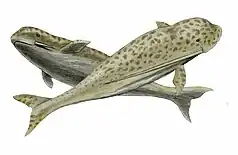Parapontoporia
Parapontoporia is an extinct genus of dolphin that lived off the Californian coast from the Late Miocene until the genus' extinction during the Pliocene.[1][2] It is related to the baiji.[3]
| Parapontoporia Temporal range: | |
|---|---|
 | |
| Reconstruction of Parapontoporia pacifica (top) with the fossil porpoise Piscolithax tedfordi | |
| Scientific classification | |
| Domain: | Eukaryota |
| Kingdom: | Animalia |
| Phylum: | Chordata |
| Class: | Mammalia |
| Order: | Artiodactyla |
| Infraorder: | Cetacea |
| Family: | Lipotidae |
| Genus: | †Parapontoporia Barnes, 1984 |
| Species | |
| |

Skull (left), along with the skull of Semirostrum.
References
- Barnes, L.G. (July 1984). "Fossil odontocetes (Mammalia: Cetacea) from the Almejas Formation, Isla Cedros, Mexico". PaleoBios. 42: 1–46.
- The Paleobiology Database
- Boessenecker, Robert W.; Poust, Ashley W. (2015). "Freshwater occurrence of the extinct dolphin Parapontoporia (Cetacea: Lipotidae) from the upper Pliocene nonmarine Tulare Formation of California". Palaeontology. 58 (3): 489–496. doi:10.1111/pala.12153. S2CID 128980362.
This article is issued from Wikipedia. The text is licensed under Creative Commons - Attribution - Sharealike. Additional terms may apply for the media files.

